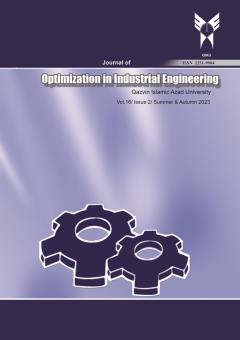Multiple Items Supplier Selection, Economic Lot-sizing, and Order Allocation Under Quantity Discount: A Genetic Algorithm Approach
Subject Areas :
Getachew Basa Bonsa
1
![]() ,
Till Becker
2
,
Abdelkader Kedir
3
,
Till Becker
2
,
Abdelkader Kedir
3
1 -
2 -
3 -
Keywords: AHP, Order allocation, Multi-criteria supplier selection, Economic Lot-Sizing, Multi-objective mixed-integer nonlinear programming,
Abstract :
The task at hand involves selecting the most suitable supplier(s), determining the optimal lot size, and allocating the total order quantities among the suppliers based on various selection criteria. However, this can become more complex when taking into account quantity discount offers and transportation selection decisions in the selection and order allocation process. To address this challenge, this paper proposes an integrated approach that combines the Analytic Hierarchy Process (AHP) with a multi-objective mixed integer nonlinear program. The approach is designed for a multi-item, capacitated multi-supplier scenario, where the goal is to select suppliers, determine lot sizes, and allocate orders while taking into account unit quantity discounts and intermodal freight costs. The proposed approach aims to minimize costs and the percentage of rejected items, while maximizing the purchasing value. To solve this problem, an efficient genetic algorithm with problem-specific operators is utilized.
Aissaoui, N., Haouari, M., & Hassini, E. (2007). Supplier selection and order lot sizing modeling : A review, 34, 3516–3540.
Boer, L. De, Labro, E., & Morlacchi, P. (2001). A review of methods supporting supplier selection . Eur J Purch Supply Manag 7 : 75-89, 7012(June), 75–89.
Çebi, F., & Bayraktar, D. (2003). An integrated approach for supplier selection. Logistics Information Management, 16(6), 395–400
Chaudhry, S. S., Forst, F. G., & Zydiak, J. L. (1993). Theory and Methodology Vendor selection with price breaks, 0, 52–66
Crama, Y., Pascual, R. J., & Torres, A. (2004). Optimal procurement decisions in the presence of total quantity discounts and alternative product recipes. European Journal of Operational Research, 159(2 SPEC. ISS.), 364–378.
Degraeve, Z., Labro, E., & Roodhooft, F. (2000). An evaluation of vendor selection models from a total cost of ownership perspective, 125, 34–58.
Dickson, G. W. (1966). An Analysis Of Vendor Selection Systems And Decisions. Journal of Purchasing, 2(1), 5–17.
Ebrahim, R. M., Razmi, J., & Haleh, H. (2009). Scatter search algorithm for supplier selection and order lot sizing under multiple price discount environment. Advances in Engineering Software, 40(9), 766–776.
Gaballa, A. A. (1977). Minimum Cost Allocation of Tenders, 389–398.
Ghodsypour, S. H., & Brien, C. O. (1998). production economics A decision support system for supplier selection using an integrated analytic hierarchy process and linear programming, 57, 199–212.
Ghodsypour, S. H., & O’Brien, C. (2001). The total cost of logistics in supplier selection, under conditions of multiple sourcing, multiple criteria and capacity constraint. International Journal of Production Economics, 73(1), 15–27.
Kasilingam, R. G., & Lee, C. P. (1996). Selection of Vendors - A Mixed-Integer Programming Approach, (I), 347–350.
Kokangul, A., & Susuz, Z. (2009). Integrated analytical hierarch process and mathematical programming to supplier selection problem with quantity discount. Appl. Math. Model., 33(3), 1417–1429.
Liao, Z., & Rittscher, J. (2007). Integration of supplier selection, procurement lot sizing and carrier selection under dynamic demand conditions. International Journal of Production Economics, 107(2), 502–510.
Mendoza, A., & Ventura, J. A. (2013). Modeling actual transportation costs in supplier selection and order quantity allocation decisions. Operational Research, 13(1), 5–25.
Monczka, R. M., Handfield, R. B., Giunipero, L. C., & Patterson, J. L. (2009). PURCHASING AND SUPPLY (4th ed.).
Pan, A. (1989). Allocation of order quantity among suppliers. Journal of Purchasing and Materials Management, 25(3), 36–39.
Pirkul, H., & Aras, O. A. (1985). Capacitated Multiple Item Ordering Problem with Quantity Discounts. IIE Transactions, 17(3), 206–211.
Rosenblatt, M. J., Herer, Y. T., & Hefter, I. (1998). Note. An Acquisition Policy for a Single Item Multi-Supplier System. Management Science, 44(11-NaN-2), S96–S100.
Sadrian, A. A., & Yoon, Y. S. (1994). A Procurement Decision Support System in Business Volume Discount Environments. Operations Research, 42(1), 14–23.
Setak, M., Sharifi, S., & Alimohammadian, A. (2012). Supplier Selection and Order Allocation Models in Supply Chain Management : A Review, 18(1), 55–72.
Swenseth, S. R., Godfrey, M. R., Mendoza, A., & Ventura, J. A. (2002). Incorporating quantity discounts to the EOQ model with transportation costs. International Journal of Production Economics, 113(2), 754–765.
Wang, T. Y., & Yang, Y. H. (2009). A fuzzy model for supplier selection in quantity discount environments. Expert Syst. Appl., 36(10), 12179–12187.
Weber, C. a., Current, J. R., & Benton, W. C. C. (1991). Vendor selection criteria and methods. Eur. J. Oper. Res., 50(1), 2–18.
Wetzstein, A., Hartmann, E., Benton, W. C., & Hohenstein, N. O. (2016). A systematic assessment of supplier selection literature – State-of-the-art and future scope. International Journal of Production Economics, 182, 304–323.


